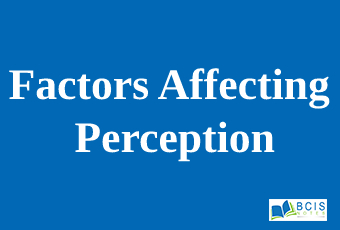
Factors affecting perception
The factors affecting perception are factors in the perceiver, factors in the target, and factors in the situation.
Factors affecting perception:
- Factors in the Perceiver
- Factors in the Target
- Factors in the Situation
Factors in the perceiver:
the following are those variables that decide the property or behavior of a perceiver.
a. attitudes:
If the people’s attitude is positive, then he/she will definitely positively pursue the perception, but if s/he takes it negatively, however, the item or the thing is impressive and quite good s/he is observing, it will observe as a bad one.
So, it is considered the factors in the perceiver which definitely affect the perception. For example; if an employee is giving his best and improving himself but the manager is not looking at his positive side but only looks for the criticism, and cannot encourage him. then the employee might turn the job for another one.
b. motives:
Motives are the motivations that cause us to work every day. They are also responsible for the perception that causes a person’s urgent needs and demands to surely influence perception. For example; in the football club, if the player wants to be selected in every starting eleven, and wants to show the best level of himself. He will definitely work hard and get praise from the manager. In this case, the perception of getting starting eleven and praise is caused by motivation and the motives the perceiver got.
c. interest:
Interest is one of the key influentials of perception. As people tend to work in a better way if they find compatible interest or enthusiasm. For example; some people are more interested in sports than the curriculum courses. If they get the proper guidance and maintenance, they will be successful in those areas. for example; the Nepalese Pubg Team got famous for playing Pubg, which is their core interest.
d. experience:
Successful experience will boost up a perception, and on the other side, failures will cause to stop and amend the perception of doing the same work again.
e. expectations:
People always have specific expectations and they will always assume those expectations on other people, jobs, or anything. For example; backbenchers are perceived as a weak students in exams by the teachers.
Factors in the target:
a. Novelty(new factor):
People surely will notice the new thing happening in the surrounding. For example; people notice the developmental works on the roads very quickly. Also, they find intriguing the facts that animals walking on the roads or something phenomenal.
b. Motion:
Secondly, motions are easily perceived by people. This principle presumes that people are more likely to focus on emotional or moving objects than non-emotional objects. Examples; soldiers in combat learn this very quickly, Adverteries make more of a moving screen than the static advertisement.
c. Sound:
Louder and frequent is the sound easier and quicker which will be factors affecting perception and vice versa.
d. Size:
This principle assumes that the larger the size, the more likely it is to be attracted by the people than the smaller size. For example; big hoarding boards are used to attract more people using the size principle.
e. Background:
It is just a similar approach in the figure-ground principle. It assumes the focus of the perceiver is always on the figure which is on the first layer and the background is ignored by the perceiver.
f. Proximity:
It assumes that proximate things are perceived easily and quickly. And also shows that an individual is always different from the other ones.
Similarity: This concept follows the moral that individuals are similar to others, and work the same way in a group. For example; an army person perceives an army staff easily.
Factors in the situation:
a. Time:
Time affects the perception in a way that if a perceiver implements the knowledge h/she just got will be more effective than the implementation after a long period of time. For example; if a student notes down what they learn in the school time after coming home on the same day, then the student will have no doubts about the subject matter again. So, time matters the most in these areas.
b. Work setting:
This principle talks about the working environment or nature of the workplace. Obviously, if an individual work in a friendly, mutually respected company, then surely s/he is motivated to get the best out of possible resources. But, if the company is old school which just focuses on the high work rate on the employees, then there will be negative impacts on the individuals.
c. Social setting:
It generally gives light on social adjustment and social judgemental. For example; if a girl wears lipstick in college, then she will be badly judged, but if she had lipstick at a party, she would be judge differently.
You may also like Learning.
If you liked our content HTML Editor, then Please don’t forget to connect with us through our social media sites. Facebook: Bcis Notes, Instagram: @bcisnotes, and Twitter:@bcisnotes.

Leave a Reply